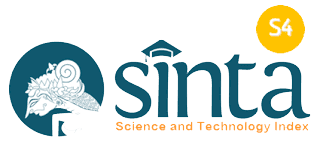Effect of Work Environment and Work Discipline On Employee Performance PT Sarana Sumut Ventura Ciputat South Tangerang City
(1) University of Pamulang, Banten, Indonesia.
(2) University of Pamulang, Banten, Indonesia.
(3) University of Pamulang, Banten, Indonesia.
(*) Corresponding Author
DOI: https://doi.org/10.26858/pdr.v5i2.31859
Abstract
This study aims to determine the effect of work environment and work discipline on employee performance, either partially or simultaneously at PT Sarana Sumut Ventura Ciputat employees, South Tangerang City. The analytical methods used in this research are validity test, reliability test, classical assumption test, descriptive analysis, simple linear regression test, multiple linear regression test, correlation coefficient test, coefficient of determination test, t test and f test. The population in this study were employees of PT Sarana Sumut Ventura Ciputat, South Tangerang City. With a total sampling of 65 respondents. The results of this study based on the coefficient of determination showed that the work environment and work discipline had a contribution to employee performance of 67% while the remaining 33% were other variables not examined. The results showed that the multiple linear regression equation was 0.277 + 0.473(X1) + 0.63 (X2), meaning that the employee's performance even without being influenced by the work environment and work discipline had an effect of 0.277. The value of the correlation coefficient of the work environment on employee performance is 0.816, meaning that the two variables have a strong level of relationship, the value of the correlation coefficient of work discipline on employee performance is 0.622, meaning that both variables have a strong levels of relationship. The results of testing the simultaneous effect of independent variables on the dependent variable obtained the value of F-count = 63.019 > F-table value = 3.15, so Hₒ is rejected and Hₐ is accepted. So it can be concluded that there is a significant influence between the work environment and work discipline on the performance of employees of PT Sarana Sumut Ventura Ciputat, South Tangerang City.
Keywords
Full Text:
PDFReferences
Akib, H., Rifdan, & Guntur, M. (2015). Quality improvement strategies of academic services and student affairs at the Graduate Program State University of Makassar, Indonesia. International Journal of Applied Business and Economic Research, 13(4).
Alfes, K., Shantz, A. D., Bailey, C., Conway, E., Monks, K., & Fu, N. (2019). Perceived human resource system strength and employee reactions toward change: Revisiting human resource’s remit as change agent. Human Resource Management, 58(3), 239–252.
Ayala, J.-C., & Manzano, G. (2014). The resilience of the entrepreneur. Influence on the success of the business. A longitudinal analysis. Journal of Economic Psychology, 42, 126–135.
Bratton, J., Gold, J., Bratton, A., & Steele, L. (2021). Human resource management. Bloomsbury Publishing.
Buller, P. F., & McEvoy, G. M. (2012). Strategy, human resource management and performance: Sharpening line of sight. Human resource management review, 22(1), 43–56.
Choi, B. C. K., & Pak, A. W. P. (2007). Multidisciplinarity, interdisciplinarity, and transdisciplinarity in health research, services, education and policy: 2. Promotors, barriers, and strategies of enhancement. Clinical and Investigative Medicine, E224–E232.
Coetzer, A., Ryan, M. M., Susomrith, P., & Suseno, Y. (2017). Challenges in addressing professional competence expectations in human resource management courses. Asia Pacific Journal of Human Resources, 55(4), 454–475.
Daoanis, L. E. (2012). Performance Appraisal System: It’s Implication to Employee Performance. International Journal of Economics and Management Sciences, 2(3), 55–62.
Isunju, J. B., Schwartz, K., Schouten, M. A., Johnson, W. P., & van Dijk, M. P. (2011). Socio-economic aspects of improved sanitation in slums: a review. Public health, 125(6), 368–376.
Jackson, S. E., Renwick, D. W. S., Jabbour, C. J. C., & Muller-Camen, M. (2011). State-of-the-art and future directions for green human resource management: Introduction to the special issue. German Journal of Human Resource Management, 25(2), 99–116.
Karami, A., Farokhzadian, J., & Foroughameri, G. (2017). Nurses’ professional competency and organizational commitment: Is it important for human resource management? PloS one, 12(11), e0187863.
Kum, F. D., Cowden, R., & Karodia, A. M. (2014). The impact of training and development on employee performance: A case study of ESCON Consulting. Singaporean Journal of Business Economics and Management Studies, 3(3), 72–105.
Macke, J., & Genari, D. (2019). Systematic literature review on sustainable human resource management. Journal of cleaner production, 208, 806–815.
Malcourant, E., Vas, A., & Zintz, T. (2015). World Anti-Doping Agency: a meta-organizational perspective. Sport, Business and Management: An International Journal.
Muftiadi, A. (2016). Productivity Analysis on Local Government-Owned Drinking Water Companies (PDAMs) in Indonesia and It’s Market Challenge. Global Conference on Business, Management, and Enterpreneurship, Universitas Pendidikan Indonesia.
Murkatik, K., Harapan, E., & Wardiah, D. (2020). The influence of professional and pedagogic competence on teacher’s performance. Journal of Social Work and Science Education, 1(1), 58–69.
Niswaty, R., Manno, J., & Akib, H. (2015). An analysis of the public service performance based on human development index in makassar city, Indonesia. International Journal of Applied Business and Economic Research (IJABER), 13(6), 4421–4429.
Papilaya, J., Soisa, T. R., & Akib, H. (2015). The influence of implementing the strategic policy in creating business climate, business environment and providing support facilities towards business empowerment on small medium craft enterprises in Ambon Indonesia. International Review of Management and Marketing, 5(2).
Porter, M. E., & Kramer, M. R. (2019). Creating shared value. In Managing sustainable business (hal. 323–346). Springer.
Rodriguez, J., & Walters, K. (2017). The importance of training and development in employee performance and evaluation. World Wide Journal of Multidisciplinary Research and Development, 3(10), 206–212.
Schorr, L. (2011). Common purpose: Strengthening families and neighborhoods to rebuild America. Anchor.
Snell, S., Morris, S., & Bohlander, G. W. (2015). Managing human resources. Cengage Learning.
Sunarsi, D. (2018a). Buku Ajar: Seminar Perencanaan Sumber Daya Manusia. Asmoro Mediatama.
Sunarsi, D. (2018b). Seminar Perencanaan Sumber Daya Manusia. ISBN - 978.602.70082.1.7.
Sunarsi, D. (2019). Seminar Sumber Daya Manusia. Unpam Press.
Wright, P. M., & McMahan, G. C. (2011). Exploring human capital: putting ‘human’back into strategic human resource management. Human resource management journal, 21(2), 93–104.
Yeoh, W., & Koronios, A. (2010). Critical success factors for business intelligence systems. Journal of computer information systems, 50(3), 23–32.
Zainal, H., Parinsi, W. K., Hasan, M., Said, F., & Akib, H. (2018). The influence of strategic assets and market orientation to the performance of family business in Makassar City, Indonesia. Academy of Strategic Management Journal, 17(6).
Zhu, Q., Sarkis, J., & Lai, K. (2012). Examining the effects of green supply chain management practices and their mediations on performance improvements. International journal of production research, 50(5), 1377–1394.
Article Metrics
Abstract view : 230 times | PDF view : 32 timesRefbacks
- There are currently no refbacks.
Copyright (c) 2022 Bachtiar Arifudin Husain, Indra Novendri, Denok Sunarsi


































